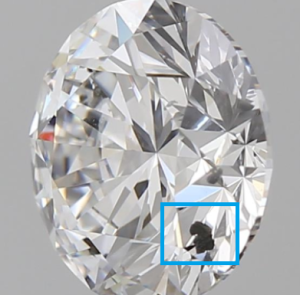Diamonds are fascinating gemstones, admired for their brilliance and rarity. Yet, they’re more than just eye-catching sparklers. Deep within their structure, they contain a world of secrets. These secrets come in the form of inclusions, internal characteristics that contribute to the diamond’s unique fingerprint. One such inclusion is ‘Crystal’.

What is a ‘Crystal’ Inclusion in Diamonds?
Crystals are minerals that form within the diamond while it is still growing underground. These inclusions can vary in size, color, and location, leading to a range of impacts on the diamond’s overall appearance and value. Some crystals are so small that they are invisible to the naked eye, while others may be large enough to impact the stone’s clarity.
The type of crystal present within the diamond can often give us a clue about the conditions in which the diamond formed. For example, garnet, diopside, and olivine crystals are usually indicative of diamonds formed in the earth’s mantle, while sulfide minerals suggest a deeper origin.
The Impact of Crystal Inclusions on a Diamond’s Value
The value of a diamond is typically influenced by the Four Cs: Carat weight, Cut, Color, and Clarity. The presence of a crystal inclusion can affect several of these factors, particularly clarity.
Clarity refers to the absence of inclusions and blemishes. A diamond with no inclusions visible to the naked eye is considered flawless. However, crystal inclusions can reduce the clarity grade, and thus, the value of the diamond. The size, number, position, color, and visibility of the inclusions determine the extent to which they affect the diamond’s value.
The Allure of Crystal Inclusions
Contrary to popular belief, inclusions are not always a disadvantage. In fact, some jewelry connoisseurs consider them unique identifiers, similar to birthmarks in humans. They make each diamond truly one-of-a-kind.
Some inclusions, like the crystal ones, can even enhance the appeal of the diamond. If they display interesting shapes, colors, or arrangements, they can contribute to the diamond’s uniqueness and story. Thus, for those who value character over flawlessness, a diamond with visible crystal inclusions might be more desirable than a flawless one.
Identifying Crystal Inclusions
Recognizing crystal inclusions can be a complex task, often requiring professional assessment. Trained gemologists typically use a 10x loupe or a microscope to identify and evaluate these inclusions.
Under magnification, crystal inclusions might look like tiny specks, lines, or clouds within the diamond. Their color can range from clear or white to black, depending on the mineral composition of the crystal.
Preserving the Beauty of Diamonds with Crystal Inclusions
If a diamond contains crystal inclusions, careful cutting and polishing can optimize its beauty. Cutters can strategically shape and facet the diamond to minimize the visibility of inclusions or to highlight them artistically, depending on the customer’s preference.
For instance, placing an inclusion near the girdle or under a facet can make it less visible. Or, if the inclusion is aesthetically pleasing, the cutter may position it in a prominent place, turning the perceived flaw into a feature.
Embracing the Crystal Inclusion
Crystal inclusions serve as a fascinating glimpse into the diamond’s geological journey. These natural formations tell a story about the diamond’s birth and growth, a story that can be hundreds of millions of years old.
While crystal inclusions may affect a diamond’s clarity, they also provide a unique fingerprint that makes each stone one of a kind. So, whether you see them as flaws or features, crystal inclusions undeniably add a layer of intrigue to the dazzling world of diamonds.